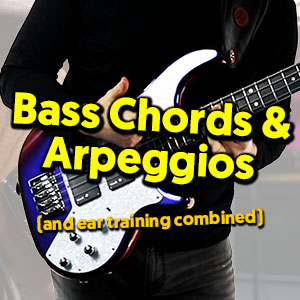In this lesson, we look at a great tip for learning scales by adding the tonic arpeggio to the end of the line. This gives you a better understanding of how scales relate to the harmony
Finding Arpeggios Within Scales
In this exercise, we will take some different scales, play each one up and down, land on the tonic and play the relevant arpeggio for that scale.
To find a triad within a scale, you simply need the root, third and fifth. In simple terms, you take every other note after the root.
1 2 3 4 5 6 7
C E G
1 3 5
Now we can see that the tonic chord in the C major scale is C major and consists of the notes C, E and G.

We can apply the exact same process to any scale. Let’s try it with the C minor scale:
C D Eb F G Ab Bb
1 2 b3 4 5 b6 b7
C Eb G
1 b3 5

Extended Chords
We can extend basic triads by including one extra note – the 7th. This is a third above the fifth and can be minor or major depending on the scale. Let’s look at the C major scale again:
C D E F G A B
1 2 3 4 5 6 7
If we count up the scale to the 7th, we can see that it is major.
C E G B
1 3 5 7
If we do the same to the natural minor scale, we will end up with a minor 7th in the chord.
C D Eb F G Ab Bb
1 2 b3 4 5 b6 b7
C Eb G Bb
1 b3 5 b7

Why Is This So Important?
Bass players often think too melodically. It is the role of the bass to ‘glue’ the band together by acting as a link between the drums and the melodic instruments (guitars, keys etc.). This is achieved by emphasising the rhythm and outlining the harmony. Therefore, arpeggios give us a way to get straight to the point and play the essential chord tones that will enforce the harmony. It is important to know scales as they are an essential part of music theory and teach us how harmony is formed, but you shouldn’t rely on them all the time as you could risk overplaying.
Modes/Chords Of The Major Scale
This last exercise works through the modes of the C major scale and should help you understand how they are all related. Again, each scale ends with the arpeggio so you can see how to apply it to a chord.




















thanks mark. you are really good at explaining theory and your lessons on applying theory to make basslines are really helpful. i think i will get more creative with time
Extremely useful. Marvelous lesson. Really great way to better understand the modes. And also now understand the music from Doe, A Deer…
How do we apply these modes???
Really helpful. There’s only one thing better than practicing scales and arpeggios. And that’s practicing more scales and arpeggios…….. And modes, chords etc. The road to paradise is paradise. Have fun learning and practicing. That’s what it’s about for me. Performing/playing well is the fruit of that fun. Yipee. Thanks Mark.
Awesome lesson, very enlightening
Mark, your instruction is great! And the material combined with the lesson, is the cherry on top. Thank you for all that you do.
Another great lesson! TalkBass could you paste few links with your bass lines played with band ?
Hi mark have you wrote book ? If yes what is the name of it if nodo you recommend one.